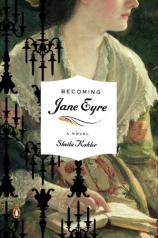Becoming Jane Eyre
Review
Becoming Jane Eyre
Using a famous name in a title is tricky. On the one hand, you draw readers in automatically: the weight of the known quantity kicks in and distinguishes your book from the rest. On the other, you are inviting comparison with a singularly gifted and enduring author whose accomplishment you cannot hope to equal. I always feel, too, that it’s not quite fair; you are piggy-backing on somebody else’s wholly created world and characters rather than going to the trouble of making your own.
BECOMING JANE EYRE, fortunately, isn’t one of those postmodern pastiches that mingles Jane Austen with zombies and sea monsters. The title might be gimmicky, but the book itself is modest and well-crafted --- a research-based fictional account of how the motherless Brontë sisters and their troubled brother, Branwell, lived and worked in Haworth, their father’s Yorkshire parsonage. Reading it, I felt certain that Sheila Kohler, a South Africa-born novelist, is as passionate as I am about JANE EYRE. She sets out to find the person behind the heroine, and the journey hasn’t been wasted.
Kohler begins her book not in Haworth but in the town of Manchester where the Brontës’ father, accompanied by Charlotte, is recuperating from an eye operation. Victorian fathers always seem to get the villain role, but Kohler reveals enough about Patrick Brontë --- a poor lad from Ireland for whom the ministry was a route to education and respectability --- to arouse our sympathy. His sins seem to be those of obliviousness more than meanness. A writer of poetry himself, he educated his daughters unusually well and took pride in their literary ambitions (even if he did sometimes dismiss their efforts as “scribbling”).
In the early chapters of BECOMING JANE EYRE, we get a lot of the father’s point of view (lying there unable to see, he thinks, remembers, speculates); indeed, throughout the book, Kohler daringly switches perspective from one Brontë sister to the other and sometimes introduces the more practical commentary of a nurse or housekeeper as well --- we hear everyone’s inner voice except Branwell’s (he is presumably too overcome by alcohol and/or drugs to think of anything except scrounging money to buy more).
Yet Branwell is still a powerful presence in the book. As the only boy, he was favored and indulged. The girls worked, soul-destroyingly, so that he could live free, but now he has returned home in disgrace and failure. Once the scene shifts to Haworth, BECOMING JANE EYRE makes it clear that the son is holding the family hostage: Emily, accompanied by her large dog, goes every night to pick him up at the pub; Patrick Brontë sleeps in the same bed to make sure he doesn’t set his sheets on fire (shades of the first Mrs. Rochester!) while inebriated.
Charlotte is enraged by this inequity and, by extension, the whole wretched condition of being a smart woman without money (of her position as governess she says, “It was slavery: thankless work without dignity”). I’d never before thought of JANE EYRE as a revenge novel, but Kohler makes a good case for the anger that drove Charlotte as she was writing it. Her fury is not only at Branwell but at her erstwhile lover, Monsieur H., the married head of the Belgian school where she had studied several years earlier. At first he responded, then shunned her.
Now, as JANE EYRE takes shape, she resolves to stop sending desperate letters to Monsieur H., to forget the twinned intimacy she and Branwell shared in childhood, and to “transform these fallible creatures into objects that will serve her purposes. She will use all those who have snubbed and ignored her. She will write out of rage, out of a deep sense of her own worth….” Frustration and despair in real life are translated into the fictional realm, where the author becomes all-powerful: Charlotte can make Jane stand up for herself; she can give her a happy ending with Mr. Rochester.
How one mines one’s own life to create another on the printed page is a deep theme of BECOMING JANE EYRE. I like Kohler’s emphasis on the process of writing (the challenge of finding uninterrupted time) and publishing (at least women today can submit manuscripts under their own names!), which will resonate with anybody who has suffered through it. There is an excruciating scene in which Anne’s AGNES GREY and Emily’s WUTHERING HEIGHTS are accepted for publication and Charlotte’s THE PROFESSOR’S HOUSE is not. All the sisters’ dreams, resentments and rivalries come into play, and it is heartbreaking.
I think Kohler sometimes draws too obvious a parallel between Charlotte’s life and certain aspects of JANE EYRE --- even unto how she thinks up her characters’ names. There are too many “Aha!” moments for complete believability. And because so much of the drama in the Brontës’ life is inward, there may be an excess of musing (and not enough actual conversation). It takes a while for the book to come alive.
But come alive it does. Perhaps the best compliment I can pay this novel is that it made me want to reread JANE EYRE and WUTHERING HEIGHTS and to try AGNES GREY. It so happens that Penguin is issuing a one-volume edition of all three at the same moment BECOMING JANE EYRE comes out. Good timing.
Reviewed by Kathy Weissman on December 22, 2010
Becoming Jane Eyre
- Publication Date: December 29, 2009
- Genres: Fiction, Historical Fiction
- Paperback: 256 pages
- Publisher: Penguin (Non-Classics)
- ISBN-10: 0143115979
- ISBN-13: 9780143115977





